RIGHT TURN ONLY!!
House of Blue Exorcists
by Carlo Santos,

The last couple of years have been an exciting time for re-releases of lapsed licenses. Cardcaptor Sakura and Magic Knights Rayearth are back, as are Sailor Moon and Love Hina ... but there is only one thing that will make my life complete.
Where is Marmalade Boy?!!
BLUE EXORCIST
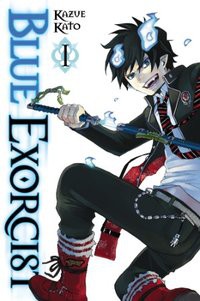
Vol. 1
(by Kazue Kato, Viz Media, $9.99)
FROM THE BACK COVER:
"Raised by Father Fujimoto, a famous exorcist, Rin Okumura never knew his real father. One day a fateful argument with Father Fujimoto forces Rin to face a terrible truth—the blood of the demon lord Satan runs in Rin's veins! Rin swears to defeat Satan, but doing that means entering the mysterious True Cross Academy and becoming an exorcist himself. Can Rin fight demons and keep his infernal bloodline a secret? It won't be easy, especially when drawing his father's sword releases the demonic power within him!"
EVIDENCE FOR:
What makes Blue Exorcist so intriguing is not morality sketched in shades of gray—rather, it's morality flipping wildly between black and white. After all, the series takes its cue from Judeo-Christian literature (note the use of fancy Biblical words to refer to the underworld), and that means a worldview where good and evil are directly opposed. Yet instead of restricting the story, this worldview opens up an powerful conflict where Rin must choose between his godly calling and his demonic urges. And it's not just morality that flips madly back and forth; Rin's family relationships also go on a rollercoaster ride as shocking truths are revealed about his father (both real and adopted) and his twin brother. This fierce maelstrom of emotions—despair, rage, guilt, vengeance, and the desire for justice—is further brought to life by Kato's kinetic art, where hellfire erupts, speedlines abound, and demonic transformations are just a fact of life. The fight scenes also strike a good balance between rich linework and allowing enough white space for the eye to rest. Don't miss out on the backgrounds either, where eclectic architectural details give the Academy a genuine fantasy vibe.
EVIDENCE AGAINST:
For all its carefully researched fantasy trappings and artistic polish, Blue Exorcist still is exactly what it is: a shonen action-adventure. The three long chapters of this volume do little to suggest that there's anything surprising or groundbreaking in store: you get Rin's boilerplate origin story (he discovers his powers by accident when someone attacks him), Rin's recruitment into the local demon-hunting squad, and then the requisite demon-hunting mission. That last one even comes with a helpless little girl and a weepy flashback—just another couple of overly familiar clichés. Meanwhile, the parts of the story that are interesting and unique—namely, Rin's bipolar battles between his good and evil nature—are marred by a lot of melodramatic yelling. Apparently the complexity of being a demonspawn while serving the cause of good is best expressed by going "RAAAUUGGHHH" and swinging your sword at everyone. Then, when the time comes to discuss serious matters quietly, the artwork suddenly turns into the equivalent of a public speaker who doesn't know what to do with his hands—the backgrounds go blank and the characters become dull to look at. So the action-adventure's there, but not a whole lot else.
FINAL VERDICT:
Surprisingly, there's enough entertainment value that the lack of originality isn't too damaging. The morally conflicted adventures of Rin Okamura begin with a B.
HOUSE OF FIVE LEAVES

Vol. 3
(by Natsume Ono, Viz Media, $12.99)
FROM THE BACK COVER:
"Just as Masa is settling into his new life as part of the Five Leaves, the gang's spy, Matsukichi, vanishes. After discovering that the reticent Matsu's disappearance is linked to an unresolved difficulty in his past, Masa decides to try to help him. To do so, he enlists the aid of the samurai Yagi. However, Yaichi, the head of the Five Leaves, is not at all pleased with Yagi's involvement. It soon becomes clear that the two men share a common past—and that something dire has shattered the bond between them."
EVIDENCE FOR:
Anyone who's been following House of Five Leaves knows what to expect with this one—no spilled blood, no sword fights, not even a ninja assassination—but the story's still as gripping as any action-packed samurai slasher. Clandestine missions, corporate rivalries, and counter-espionage are what make the Matsukichi story arc a winner, with the first four chapters buzzing with suspense all the way until the missing party makes it home and issues are resolved. Even more remarkable is how Ono weaves character development into it, with a flashback to how Matsu joined the Five Leaves in the first place—a wry, well-plotted story-within-the-story—and some new shades of intrigue about Yaichi's past. The back half of the volume is a bit more lighthearted, with Masa's sheltered little sister paying a visit and learning the worldly ways of Edo, but the fascinating characters and their interactions make every moment an edifying one. The sketchy, ink-brushed style of art fits the understated mood perfectly, while clean rectangular panels and silent sequences also add to the series' thoughtful nature. And there's definitely lots of thinking to do about the gradually-developing undercurrent between Yagi and Yaichi ...
EVIDENCE AGAINST:
Oh my goodness Natsume Ono, one of these days I am going to strangle those droopy-eyed wide-mouthed characters you put in everything. Yes, for all the artistic individualism, there is no mistaking the fact that Ono only draws one kind of face and then just grafts different hairstyles, chins, and cheekbones onto each one. Among the main characters alone, there's about four different guys who all wear topknots and samurai garb—yet if the designs were more varied, the character guide in the preface wouldn't be necessary. The homogeneity of the visual style also makes it hard to follow scene changes at times, which is especially confusing when switching in and out of flashbacks, as well as scene changes where different sets of characters are speaking to each other. Blame it on the sparse backgrounds—if everything looks like a generic feudal Japanese household, how are you supposed to tell when the action's moved to a different household? Not that there is much action to speak of anyway—it's true that the series can hold its own even without swordfights, but it often errs in the opposite direction with too much idle conversation.
FINAL VERDICT:
The idiosyncratic art and laid-back mood may not be for everyone, but what it does bring as far as complex plotlines and intriguing characters is strong enough to earn a B+.
K-ON!

Vol. 2
(by kakifly, Yen Press, $11.99)
FROM THE BACK COVER:
"It's been almost a year since the girls of the pop-music club started jamming together, but the start of the new year is no time to look back on their journey—it's time to recruit new members! Despite their inexperience, the girls' passionate performance at the entrance ceremony impresses first-year Azusa, a budding guitar player who can't wait to join. But she didn't expect there to be so much tea drinking in the pop-music club. Or cosplaying ... When do they get around to making music?!"
EVIDENCE FOR:
For true fans, there are only two words needed to sell K-ON!'s second volume: Azusa freakin' Nakano. Okay, that's three words, but such is her galvanizing presence—a precocious workhorse whose stern attitude complements the flakes and weirdos in the cast. Basically, Azusa's totally different from everyone else, and that clash of personalities is what brings Volume 2 to life. She cusses out her elders, rages about rehearsal time while everyone's on tea break, and basically proves that the secret of moe is not about being saccharine and submissive but letting out one's personality in all its flawed glory. This volume also showcases a wider range of story material, moving away from school life and trying out new scenarios like a getaway at Tsumugi's family resort and a maintenance visit at the local guitar store. (Just watch Mio geek out over the left-handed basses!) And where other four-panel strips try to cram too much into a small space, this one does the right thing by keeping the panels clear and letting in only one or two characters in at a time, thus keeping a clean, steady visual flow. Having distinct, appealing character designs sure helps, too.
EVIDENCE AGAINST:
If the newcomer gets to be the star, then guess what that means for everyone else? That's right, they all get pushed into the shadows! The entire first half of this volume seems to be nothing more than The Azusa Show, with every other gag pointing out how she feels about being recruited, and how she fits in with the rest of the band, and how she tries to resolve the balance between leisure time and practice time ... Basically, if you were interested in any of the other girls and wanted to see how their personalities bounce off each other, this is not the volume for you; the main interaction going on here is how Azusa's personality bounces off everyone else. The series' sense of humor is similarly one-sided, relying on the same kind of joke over and over—a telegraphed overreaction whenever one of the girls unwittingly does something bizarre. After a while, all the screaming of "Goodness gracious! How can Yui play when she has no technical knowledge?!" and so on just gets tiresome. And the lack of detail in the art makes it visually boring after a few chapters.
FINAL VERDICT:
A single new character shouldn't have to carry the entire series—and it's that lack of balance, despite Azusa's obvious charms, that lands this volume at B-.
MARCH STORY
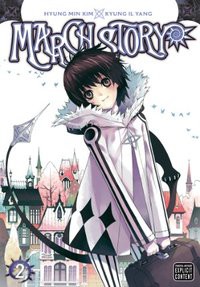
Vol. 2
(by Kim Hyung-Min and Yang Kyung-Il, Viz Media, $12.99)
FROM THE BACK COVER:
"Among the quiet villages and towns of 18th century Europe, demons known as the Ill hide within the most beautiful works of art, sparked to life by the torment of their creators. Attracted by their jewel-like allure, the unwary find themselves possessed by the Ill and driven to horrific acts of violence. Only the hunters of the Ciste Vihad can dispel the Ill.
Working out of Rodin's antique shop, March and the powerful yet compassionate Ciste Vihad Jake travel the land purging the Ill wherever they find them. Although some types of Ill may possess a tragic innocence, even these misunderstood beings can cause problems only the Ciste Vihad can solve. Even so, the most terrifying Ill are spawned within the darkest depths of human wickedness, and it will take all of March's strength to face them."
EVIDENCE FOR:
With the second volume of March Story, artist Yang Kyung-Il proves that he still has plenty of magic up his sleeves, creating images of both incredible beauty and horror. Yang's most striking work can be found in his departures from reality: a dreamy forest glowing in pure white, a mutilated child seeking revenge, and of course the thorny vines that issue forth from March's staff when it's vanquishing time. But it is a mundane image—that of a mother cradling her infant—that inspires the most memorable chapter in this volume, if not the whole series so far. It's a story both heartbreaking and beautiful, with fairytale twists worthy of Neil Gaiman, and proving that not every March Story adventure is a simple demon-hunting exercise. At the same time, writer Kim also continues to build upon the main cast of characters, with a sweet little flashback about shopkeeper Rodin and the addition of a new Ciste Vihad whose testosterone-oozing manliness perfectly balances out March's delicate androgyny. (It also leads to some bathtime comedy.) And when March's emotions boil over in the last chapter ... let's not forget the monster lurking within the hero, either.
EVIDENCE AGAINST:
One standout story and a new supporting character? That's it? Remember, this is a nearly 200-page book and just because there were 40 really good ones doesn't excuse the rest. The first chapter, despite its surreal trappings, is a hokey love story that may leave one wondering why the tale even needed to be told in the first place. After that comes the Rodin-centric character sketch, but again, it's built on a flimsy romance that seems to exist purely for the cloying emotional manipulation that comes at the end. Plus it never seems sure whether it's trying to tell the brunt of the story through flashback or through present-day action. The fourth and final chapter, despite taking things more seriously and loading up on tough moral issues, also falls short, turning into exactly the kind of demon-hunting exercise that the series is supposed to have improved upon. You just can't win with these stories—they'll do one thing right, but then come up short in some other aspect. Even the art is that way sometimes, as Yang gets too ahead of himself and clutters things up with fancy effects and patterns.
FINAL VERDICT:
I really want to like this series—after all, the artwork is to die for—but so far, there are still flaws that holds it back from greatness. So it remains C material right now.
THE SECRET NOTES OF LADY KANOKO
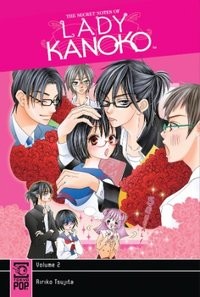
Vol. 2
(by RIRIKO Tsujita, Tokyopop, $10.99)
FROM THE BACK COVER:
"It's her 3rd year of junior high, and Kanoko has to change schools again! Despite the change, Kanoko continues to be the perfect 'objective observer.' Conflicts between a tomboy and a cutesy girl, and a rivalry between a narcissistic risk-avoider and a delusional girl who escapes into a fantasy world are new additions to Lady Kanoko's secret notebook. Meanwhile, Kanoko tries to solve a series of mysterious accidents involving some of the hottest young actors."
EVIDENCE FOR:
Everyone knows that mainstream shoujo is the place to be for exploring human emotions—and in that respect, Lady Kanoko goes completely above and beyond. If you thought the twists and head games in a series like 20th Century Boys were dizzying, try figuring out the motives of schoolkids searching for love and validation, where even a girl who's "blunt and honest" may be putting on an act, and a boy trying to live up to his brother's accomplishments turns the other way as a defense mechanism. It's psychological gamesmanship from cover to cover, and because there are so many layers of emotion—so many possible modes of deception—it's a game to be played with the head as well as the heart. Shoujo for people who love to overanalyze shoujo, if you will. Even the far-fetched movie-star chapter offers twists and turns and double-crosses to go with its sharp criticism of the idol business. And standing in the eye of the storm is Kanoko herself, charming as ever with her scheming grin and sarcastic putdowns. She may be "completely objective," but you just can't help but subjectively love her.
EVIDENCE AGAINST:
Someone needs to tell Miss Kanoko that her notes are too crowded—at least from a visual perspective. Just as the series is elevated by its complex, head-spinning drama, so is it also lowered by the messy art used to render that drama. Too many scenes in this volume look like a pained struggle to fit within the page limit, and just about every "action scene" makes it clear that RIRIKO Tsujita was never born to draw action. The most obvious weaknesses, though, come in the character designs: there may be an entertaining variety of them, but watch as they drift off-model, and cringe as crooked linework turns pretty faces into disturbing ones. It's not just the artwork that veers into sloppiness, either: the storytelling also goes into brainless autopilot at times, with old buddy Haru dropping in every chapter for trivial reasons, and a cast-of-characters sidebar being used as a substitute for proper exposition. Maybe it's time to drop the "meet new characters every chapter" formula and develop a proper storyline?
FINAL VERDICT:
For all its flaws in execution, it's still way too much fun following each story thread and piecing the characters' motives together. So this volume makes off with a B.

VAMPIRE CHEERLEADERS
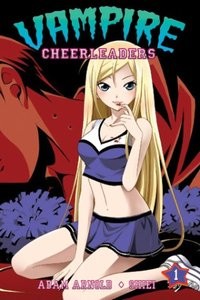
Vol. 1
(by Adam Arnold, Shiei and Comipa, Seven Seas, $10.99)
FROM THE BACK COVER:
"Vampire Cheerleaders
The Bakertown High School cheerleading squad has a secret: behind all their pretty makeup and short skirts are five hungry vampires who sure know how to show their school spirit!
When one of their own turns up missing, the vampire cheerleaders have no other choice but to induct one of the eleventh grade girls from 'B Squad' into their vixenous ranks. Siring new recruit Heather Hartley may be the easy part, but keeping her from becoming a vamp-gone-wild and draining the entire football team on the eve of the big homecoming game is another matter!
Paranormal Mystery Squad
Goth girl Stephanie Kane, her bratty sister Katie, and best friend Charlotte have a good thing going. They've made a name for themselves traveling the country in their trusty Winnebago hunting down cryptids and all manners of supernatural beasties. That is, until the organization known as PETM (People for the Ethical Treatment of Monsters) slaps them with a boatload of new regulations and places a court-appointed PETM liaison on their all-girl team: the enigmatic, albeit slightly anemic, J.C. Summerfield.
When things go awry during the team's next case, it's Stephanie's kid sister Katie who finds herself in the hairiest situation of her life...literally!"
EVIDENCE FOR:
The title alone should tell you that Vampire Cheerleaders is pure, unadulterated camp—and professional fanboy Adam Arnold wastes absolutely no time in milking every possible gag out of it. Most big-name vampire franchises have a problem with taking themselves way too seriously, and this one spoofs them all with its self-referential humor, outspoken characters, and satirical view of the American public-school experience. The witty parallels between an elite school clique and an elite supernatural clique are easy to see, and the humorous montages where Heather goes through her vampire "training" add to the silliness. The final act even pulls off a few surprises, including a rogue vampire hunter who has the tables turned on him last-minute. In addition, the clean, sure-handed art from Shiei (plus a few tasty dollops of fanservice) makes the story a satisfying package inside and out. Meanwhile, the Paranormal Mystery Squad story—a sort of B-side occupying the back half of this volume—plays off the same supernatural-spoof idea, but with werewolves and a Ghostbusters-like team of hunters. Again, it's Arnold's unapologetically lowbrow humor (ah, so lycanthropy is triggered by sexual arousal?) that enlivens this mad pop-culture collision.
EVIDENCE AGAINST:
The trouble with going for "stupid-funny" is that if the humor misses ... it just comes out stupid. For every broad guffaw in this volume, there are also plenty of forced, self-conscious gags—the kind where the guy telling the joke starts laughing at himself in hopes that someone else will follow. The Twilight mockery in the first story already feels old and lame (and the fourth movie hasn't even come out yet!), while plot points that hinge on women's bodily functions in the second story seem exploitative and awkward coming from a male author. But the biggest slip-up this book makes is in switching artists between Vampire Cheerleaders and Paranormal Mystery Squad—the latter ends up looking like a mess due to the change in style and skill level, with overblown action scenes and shaky character anatomy. So even though the two stories come from the same writer, with similar comedic themes, the "B-side" comes out clunkier than its predecessor. Not that the main track is perfect, either: sometimes the clean, glossy style looks too bland and leaves the whole page feeling rather lifeless.
FINAL VERDICT:
Well, this isn't going to win any artsy-fartsy awards, but its bawdy, irreverent attitude is a soothing balm for those who want a break from overly serious genres.

This week we're taking a dip in the manhwa pool! This time it's RTO regular R. Silverman leading the way to a little-known gem about the trials of high school life.
And remember, even if this is your first time reading this column, it's always the right time to send in your own reviews. Share your opinions and join in the fun!
NARRATION OF LOVE AT 17
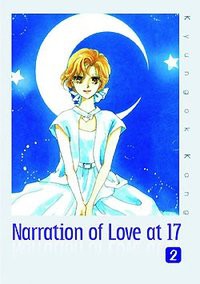
Vols. 1-2
(by Kyungok Kang, Net Comics, $9.99 ea. (out of print), ~$3 used)
Boy or girl, we've all been Seyoung Kang.
She's a seventeen-year-old high school sophomore/first year. She's not as attractive as she'd like to be. She's not as successful as she'd like to be. The guy she likes and the parts she wants all seem to go to the pretty girl. And worst of all, she has a sneaking suspicion that this is how it's always going to be.
That's the plot in a nutshell, but Kyungok Kang's four volume narrative is more than the sum of its adolescent parts. Seyoung looks like a tomboy but is an aspiring actress. She's got a major crush on her buddy Hyunwoo and a burning desire to get the lead in the drama club's play, but all of this goes south when Hyemi moves to the neighborhood. Hyemi is That Girl most of us are familiar with—she's pretty, she's talented, and the pretty outweighs the talent when she's put up against the equally skilled Seyoung. Needless to say she's also fascinating to Hyunwoo, further antagonizing Seyoung. And the worst part is, she tries to be nice. Seyoung is forced to admit to herself that she doesn't think she can ever like Hyemi while feeling terrible about it. This still sounds like basic shoujo fare, but Kang has a light touch that takes the melodrama out and creates a sense of familiarity. This is not a nostalgia piece—at no point in these first two volumes does the reader long to return to the imagined good times of high school. Instead it is a gentle reminder of what it felt like to be seventeen and confused, to be certain the no matter what you did and how hard you tried, nothing was going to go right. It's a story to read when you have a bad day at work, to make yourself feel better about how life has changed, and maybe turned out.
The art, like the story, is old-school. The copyright states that the volumes were published in Korea in 1991, but a date of 1989 graces some pictures. References to 80's pop culture abound, but on the whole it isn't distracting. Some readers might be jarred by scenes of people writing down their home phone numbers since the series predates cell phones, but on the whole the dated feel works with the nature of the story. Backgrounds are detailed when they should be and absent when they aren't important. The characters are mostly easily distinguishable, although it IS the 80s and mullets and rat tails abound.
Net Comics was one of the best selectors of manhwa to translate and this story is no exception. Two of Kang's other works were partially translated before they stopped printing volumes (In the Starlight and Two Will Come, both excellent), and we're lucky that all four volumes of this series made it into print. Narration of Love at 17 is a slow, true story that understands how it felt to be an insecure adolescent and makes you wish that you could reach into the pages, give Seyoung a big hug, and tell her that yes, it does get better.
Is there a hidden gem of manga you'd like to reveal to the world? Is there a piece of garbage that deserves to be bashed in public? Or is there a title that didn't get a fair grade here, and you want to set the record straight?
Now's YOUR chance to be the reviewer! Write a review of about 300-400 words (a little more or less is fine) and include:
- your name.
- Title of manga (and volume no., if applicable)
- Author/Artist
- Publisher
- Briefly describe the story, then explain why this manga is great, terrible, or in between. Be objective, but also be entertaining.
Then send it in to rtoreaders (at) gmail (dot) com (plain text format preferred). One review will be selected out of all the submissions and will be published in the next column. All types of manga and manga-inspired comickry are accepted, from past and present, from Japan and beyond—what matters is that it's the Reader's Choice! NOTE: Submissions may be edited for formatting and grammar.
discuss this in the forum (4 posts) |
this article has been modified since it was originally posted; see change history